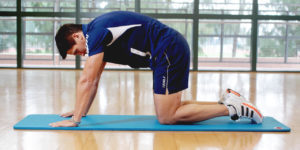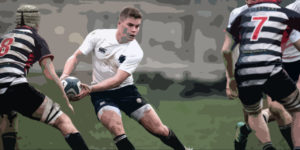Best balance training for rugby players
- Patrick Dale
- Injury Prevention, Training
While cardiovascular fitness, strength, and power are obvious requisites for successful rugby, there is another form of fitness that can help improve your rugby performance: balance. Balance is properly defined as your ability to keep your center of gravity over your base of support.
Balance can be static or dynamic, and both kinds are important in rugby. If you have good balance, you’ll be able to lift bigger weights in the gym, sprint faster on the pitch, tackle harder, dodge more smoothly, and potentially suffer fewer injuries.
Despite the benefits of having good balance, very few ruggers do much in the way of balance training. In fact, the nearest most players will ever come to balance training will be playing the game of rugby. After all, whenever you are on one leg and not two, your balance is being tested and developed.
However, balance-specific training can pay off, especially in the pre-season or off-season. If you have good balance, you’ll waste less energy trying to correct your improper body position and, in rugby terms, spend more time on your feet and less time on your butt or back!
If you are one of those players who is always tripping over his own feet, you NEED to work on your balance. After all, if you are not on your feet, you are out of the game.
Balance is a skill that some people have in buckets, and other people naturally struggle with. However, because it is a skill, balance can be trained. You might never develop the balance of an elite gymnast or tightrope walker, but you should be able to improve your balance so that you are no longer that clumsy rugger who falls over whenever a strong wind blows across the pitch!
How you balance
Balance is something most of us don’t think about until it’s challenged. Good balance should be automatic and is the result of three biological systems working together in harmony. Those three systems are:
1) The vestibular system – these are the sense organs in your head and inner ear. Their job is to regulate equilibrium and provide you with directional information. Think of the vestibular system as your built-in spirit level bubble.
This is why ear problems can cause issues with balance. Because of this, you should take steps to protect your ears from loud noises. Very loud music, especially when using headphones, can damage your ears and that could contribute to loss of balance. Always listening to your cellphone in the same air can also lead to ear problems.
2) The somatosensory system – nerves in your joints and skin called proprioceptors detect the position of your limbs, telling your brain where they are in space. This system is why you can touch your fingers to your nose with your eyes closed.
The somatosensory system is also why your body can respond to things like unseen divots on the ground and still maintain your balance. However, repetitive injuries can damage the proprioceptors, which impairs balance and increases the risk of suffering the same injury again. For example, “weak ankles” are often the result of damaged proprioceptors, and once the proprioceptors are strengthened, injury rates fall. Injury prevention training is one of the best precautions you can take for rugby.
3) The visual system – what you see has a big impact on balance. It provides you with an object to focus on, which makes maintaining your balance easier. Most people are over-reliant on the visual system for balance which is why it’s often much harder to perform feats of balance with your eyes closed. Try standing on one leg with your eyes open and then your eyes closed to experience this for yourself.
In summary, to have good balance, you need good eyes, good ears, and healthy muscles and joints. If anyone of these systems is lacking, your balance will suffer.
How to improve your balance for rugby
Balance is a trainable fitness component. If you regularly perform balance exercises, your ability to keep your center of gravity over your base of support will improve as your body “learns” to use the three balance systems more effectively. This does not mean you should start doing all your strength training while standing on one leg, or using a stability ball or wobble board. You can have too much of a good thing!
While you CAN combine balance training with strength training, it’s not always a good idea. Doing squats while standing on a wobble board will limit force production and therefore strength development, so while your balance will improve, your strength will decline.
Many so-called functional balance exercises focus more on balance than they do strength and, as a rugger, you need both. Instead, balance training should be done separately or in addition to strength training. You could perform balance training:
- Prior to your regular strength program to fire up your nervous system – you may find that you feel more stable as a result e.g. single leg Romanian deadlifts prior to regular barbell deadlifts
- After your planned training session – after all, in rugby you need to have good balance even when fatigued
- Separate to regular training – balance training is relatively low intensity and should not have much impact on recovery
Gymnastic training is another great way to enhance balance – read more about using gymnastics for rugby training in this article.
Balance training should definitely be part of any post-injury rehab as it may help reduce the chances of re-injury.
Balance exercises for ruggers
Use these exercises to improve your balance for rugby. Ideally, you should do your balance training barefooted to maximize the recruitment of your proprioceptors. Standing on a folded gym towel will also help increase the involvement of the proprioceptors.
You could also progress to using a balance trainer such as an Airex pad, foam pillow, BOSU ball, or wobble board. However, doing these exercises on the floor should be sufficient for most exercises.
Avoid doing these exercises in front of a mirror as that can lead to an over-reliance of the visual balance system. Same advice as we’ve given for our leg workout.
Exercises are listed in approximate order of difficulty.
1) Single leg standing
You can do this exercise anywhere, anytime. Do it when you are taking a phone call, brushing your teeth, or any other time you have a few minutes to spare.
Simply stand on one leg for 30-60 seconds, and then change sides. It’s very normal to find your balance is better on one side or the other. If that is true for you, do an extra set on your weaker side to bring it up to scratch.
Make this exercise harder by moving your arms or non-supporting leg out to the side to shift your center of gravity, closing your eyes, or adding an additional movement such as bouncing a tennis ball on the floor or against a nearby wall. You could also do this exercise with your teammates, passing a rugby ball from player to player.
2) Stork press
This exercise takes one leg standing up a notch. Standing on one leg, lift and hold a light dumbbell in your opposite hand. While attempting to maintain your balance, press the dumbbell overhead. Do 12-15 reps and then swap sides. You can also perform this exercise with the weight on the same side to make it more demanding. Closing your eyes also makes this exercise harder.
See the stork press exercise in action here:
3) Single leg Romanian deadlift
With or without weight, stand on one leg and then hinge forward from the hips, extending your non-supporting leg behind you to act as a counter-balance. Reach down toward your toes. Stand up straight and repeat. If you do use a weight, start off by holding it in both hands before progressing to just one hand. Experiment with holding the weight on the same and the opposite side as your supporting leg. Once you’ve mastered these, try throwing them in with Jefferson curls to really conquer your posterior chain.
Here’s a video of how to do the single leg Romanian deadlift:
4) Jump and stick
This exercise teaches you reactive balance i.e. correcting your balance after a destabilizing event. Simply jump up and then attempt to stick the landing perfectly i.e. no wobbling, staggering, or other extraneous movements.
Once you have achieved a reasonable level of proficiency, try jumping forward, sideways, diagonally, and backward, as well as jumping on command. You can also add mid-air turns to really increase the difficulty. Once you have mastered two-footed jumps, you can progress to single-leg hops.
Check out this video to see the jump and stick exercise in action:
5) Slacklining
Slacklining is an accessible form of tightrope walking. Slack lines are usually set up much lower to the ground, and are wider than tightropes. Also, the relative slackness that gives this activity its name makes them more forgiving than walking a much more rigid tightrope. You can buy slacklining kits from specialist outdoor stores and all you need to two sturdy anchors to fix your slackline to. Slacklining is not just a good way to increase your balance, it’ll also strengthen your core and deep stabilizer muscles. It’s also a cool party trick!
Here’s a video introduction to slacklining:
Balance training is not only important for ruggers, it can be a lot of fun too. Most rugby training is hard, taking a huge amount of energy – that’s why Post-Rugby nutrition is so important. Balance training is much less intense, and should be something that you can actually learn to enjoy. And if you are new to balance training, you’ll also see some big improvements very quickly.


